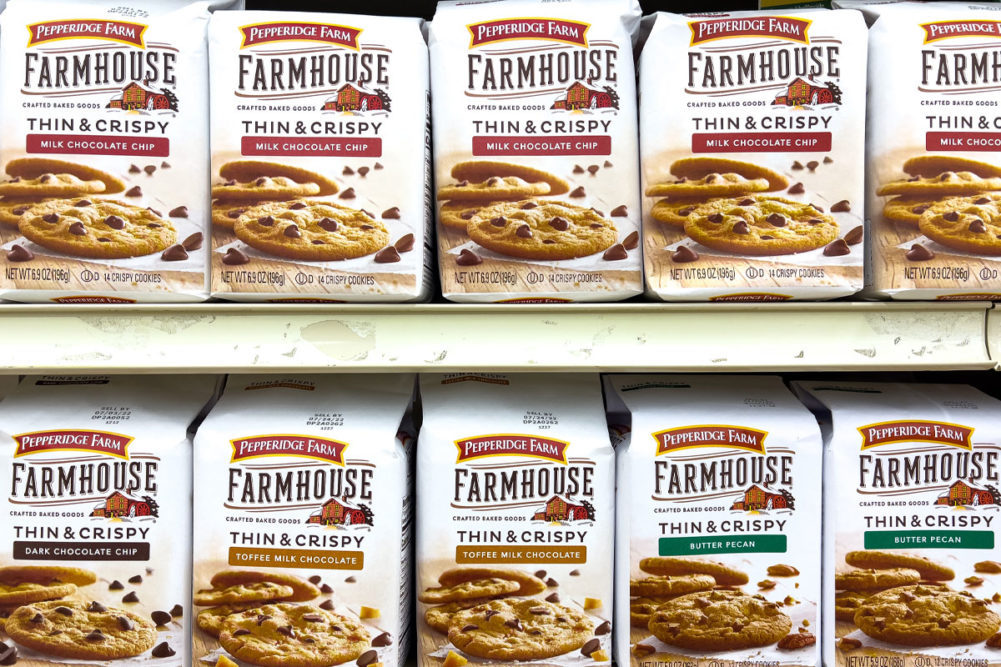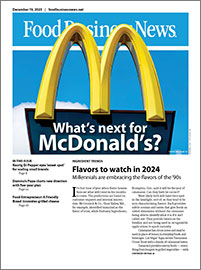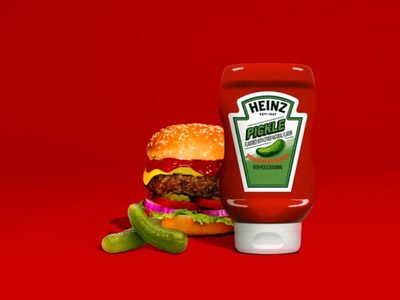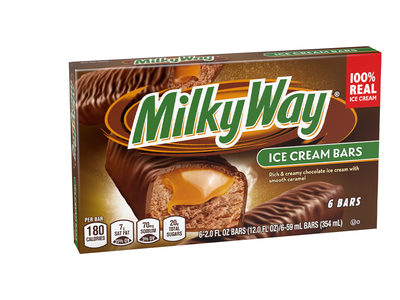KANSAS CITY — People need a little boost sometimes. It may be a sweet favorite or a zingy new tidbit to brighten their day. Cookies are a go-to option for a snacking nation, and consumers who have been gravitating toward indulgent treats are sticking with them.
“It’s important to keep in mind that cookies are a part of the fabric of people’s lives,” said Lynn Dornblaser, director of innovation and insight for the market researcher Mintel. “They are an everyday product, a special treat and everything in between.
“Also, we see more consumers being willing to enjoy indulgences, and cookies fit right in. They may be, in many cases, considered a ‘permissible indulgence,’ as packaged cookies, especially, are smaller in size and can be easily portioned out. In these uncertain economic times, they also represent an affordable luxury.”
Cookies are the perfect size for a snack, accessible and affordable, and sales are on the upswing. Center store dollar sales for cookies jumped 22% for the 52 weeks ended July 16, and unit sales were up 6%, according to Circana. Perimeter cookie dollar sales were up 13%, with unit sales up 1.4%. Total cookie sales topped $9.6 billion during that period.
“When we break down the categories of better-for-you, permissible indulgence, indulgence and treating, for the last three years, indulgence has outpaced the other three,” said Sally Lyons Wyatt, executive vice president and practice leader for client insights, Circana. “I haven’t seen it let up yet. Now, it’s going to at some point. But for the foreseeable future, I still think indulgence is winning. And it’s because the macroeconomic headwinds work in its favor. You’ve got concerns over what’s going to come next, whether it’s more pricing, is gas going to go up? You’ve got the looming student loan debt that could hit a lot of consumers. All of that causes stress. Consumers notoriously gravitate to something that makes them feel a little better when it comes to snacking and food and beverages, and cookies is right there.”
While dollar sales for crackers were up 13% for the 52 weeks ended July 16, unit sales dropped 4%. Consumers are still enjoying their traditional favorites, but healthy choices are popping up.
“When we look at some of what is winning within crackers, there are pockets of growth,” Ms. Lyons Wyatt said. “One of them is around health and well-being claims. It might be gluten-free, whole grain, non-GMO. Those have done quite well from the cracker standpoint. ... They are winning not just for the segment of the population that needs it, but they’re winning some new consumers because the taste is quite good.”
Consumers want their treats to be delicious, and they are not only going for traditional flavors but seeking out new ones as well.
“Cookies struggled for a while trying to find their footing from a center store perspective; perimeter cookies were actually outpacing center store,” Ms. Lyons Wyatt said. “But in ’22, both center store cookies and perimeter cookies are growing. Perimeter cookies are still growing; they’re just not growing as fast as center store. When you look at cookies and where the biggest winners are, they’re traditional: chocolate chip, sugar. Those that come in multipacks where you can get a dozen, two dozen, and you can pick up a variety of different ones, those have also seen growth.”
Most of the growth at Otis Spunkmeyer, a brand owned by Los Angeles-based Aspire Bakeries, is being seen in core flavors, especially chocolate, said Paul Stippich, director of marketing for the brand.
“Cookie sales have been steadily increasing, with the most growth still taking place within the core flavors, especially chocolate-based flavors,” he said. “Chocolate, most notably chocolate chip, has been and probably always will be the flavor that consumers reach for time and time again.”
But he added that consumers are open to flavor innovation as well.
“We are seeing new flavors emerging, especially as citrus profiles have started to make their entrance into the cookie world,” Mr. Stippich said. “The ingredient niches across the cookie spectrum, vegetable-fortified and protein-fortified, are still present, however consumers are less inspired by them than they are by new and exciting flavors.”
The most common flavors are chocolate and vanilla, and they both are growing in terms of the total percent of cookies introduced in the United States, Ms. Dornblaser said.
“A few interesting flavors that appear in very small numbers of products yet show significant growth show the wide variety of cookies out there: olive oil, maple, purple yam, popping candy,” she added. “There has also been an increase in seasonal and limited-edition flavors, which are often those that are a bit unique or different.”
Seasonal flavors are always a popular choice and are trending at Cheryl’s Cookies, Westerville, Ohio.
“We are seeing great success in our seasonal favorites with customers already gravitating toward our fall assortment — especially anything pumpkin-flavored,” said Kara Jaggers, vice president of merchandising at Cheryl’s Cookies. “Cinnamon sugar and s’mores/hot cocoa are very popular flavor profiles right now that we have in our line. Also, our brand-new buttercream frosted cupcake line is doing very well in all flavors — including pumpkin, chocolate and vanilla. Each of our individually wrapped cupcakes are topped with a snack-size cookie.”
Galaxy Desserts, Richmond, Calif., which sells French-made macarons under the brand name Brioche Pasquier, offers classic flavors such as chocolate, lemon, vanilla and pistachio as well as a gourmet macaron collection with such flavors as salted caramel, fig poppy seed, coconut and more.
“The goal at the beginning was really to bring the flavors that are most popular in France,” said Julien Suignard, sales director for Galaxy Desserts. “That is working, which is really good news for us. After that, because we wanted to build the market, we wanted to try United States flavors. The goal is really to do both.”
The company strives to present flavors that stand out while maintaining what sets their macarons apart.
“We want to keep what makes us unique,” Mr. Suignard said. “For example, a macaron needs to have a double texture. It needs to be crunchy outside and soft inside. Whether it’s red velvet or birthday cake that is typically American, we don’t want to change the textural experience.”
Varieties and value sought
Cookies are an affordable, everyday indulgence that have people seeking multipacks that offer variety at a lower price. Center-store multipack cookie dollar sales leapt 44% in the 52 weeks ended July 16, according to Circana, and unit sales surged 40%. Perimeter assorted/multipacks were also up nearly 14% in dollar sales and 4.2% in unit sales during the same period.
“The (in-store) bakery offers so many different package sizes and the same thing for those snack cookies in the commercial aisle,” Jonna Parker, principal II, fresh foods team lead with Circana, said during an International Dairy Deli Bakery Association webinar in June. “You’ve got mini pouches, you’ve got take-along, you’ve got multiple sizes, and yes, you’ve got platters and things for parties.”
She pointed out that for events, cookies’ strength is in the variety they offer.
“If you have a cake, everyone has to like that flavor of cake,” she said. “With cookies you could put a few out, and if someone wants to nibble, they can do that easier than with cake or a cupcake or brownie.”
The rise in perimeter sales is not surprising because inflation drives consumer purchases, Mr. Stippich said.
“All of us like to enjoy a sweet treat, and high prices are restraining consumers from purchasing premium desserts and the sweet options they love,” he said. “When compared to other desserts, cookies are going to be lower in price but can still be considered premium. Multipacks of cookies are positioned as an extension of savings, given that you are buying multiple cookies for a lower average price.”
Mr. Suignard said Galaxy Desserts’ variety packs that offer more variety do better. For example, the 12-count boxes with only two or three flavors are not as popular as the same-size boxes with more flavors.
“Variety is really important for the consumer,” he said. “Every time we offer more flavors, we have better success.”
The company is working on larger packs as well, although they are not available yet.
“We know people gather at the end of the year, so we are working on larger boxes of macarons for sharing,” Mr. Suignard added.
There may be several reasons why multipack cookie sales are surging.
“We’ve seen multipacks growing in a variety of other snacking categories because of a variety of reasons,” Ms. Lyons Wyatt said. “That could be because they want to please different members in a household, they like the variety, they like the on-the-go, so there’s not one reason but several that are really driving that.”
Demand for healthy rising
Indulgence may be winning the hearts of most consumers, but many are still looking for cookies that provide added value: nutrition benefits, dietary requirements and even sustainability.
In June, global market research firm Technavio said one of the key drivers of the cookie market over the next several years will be the rising demand for healthy cookies and those with clean labels, according to a report released in July.
“Consumers are becoming more health-conscious and are opting for healthier food options with the increase in the prevalence of chronic diseases,” Technavio reported. “Vendors are offering different new products, with unique flavors, safe ingredients and packaging. The increasing priority on healthy eating will expand the demand for low-calorie cookies.”
Launches with ethical claims are on the rise, too, in the United States, especially around sustainability and human rights, Ms. Dornblaser said.
“Consumer interest in specialized diets — for example, gluten-free, paleo, vegan — is also inspiring launches,” she said. “Health is also a factor, but the focus is on ‘no bad stuff,’ as in no artificial flavors or colors, no additives or preservatives, and claims around no or low sugar. These are the claims that are growing the fastest, but it should be noted that they are also some of the smallest claims.”
Ms. Dornblaser also said there’s more room for wellness benefits, such as added protein, fiber, and vitamin and mineral content.
“Note that the low/no/reduced sugar claim appeared on just over 3% of product introductions in 2022, up 73% from 2020 figures,” she said.
Cheryl’s Cookies offers vegan, gluten-free and sugar-free bakery assortments.
“The market is growing for these alternative options, and by offering these product categories, we are able to expand our brand to gain new customers,” Ms. Jaggers said. “It’s very hard to find truly delicious cookies that meet specific dietary requirements, and Cheryl’s Cookies has been able to accomplish just that.”
The power of charcuterie
Consumers are gobbling up crackers to the tune of $9.4 billion in sales for the 52 weeks ended July 16.
“When you think about flavors for crackers, there’s a couple of crackers out there that do a lot of extra cheese, like extra cheddar, that have done quite well,” Ms. Lyons Wyatt said. “Everything-flavored crackers have done well and on the sweet side, cinnamon. Smaller hits that have done well are that sweet-and-salty combo.”
The popularity of charcuterie boards over the past few years has provided a boost for crackers, although unit sales are down a bit, and producers could benefit from letting consumers know how well their crackers fit onto boards.
“Charcuterie boards were what helped fuel crackers for a long time,” Ms. Lyons Wyatt added. “I still think crackers that are growing are part of that. ... Charcuterie and boards are still alive and well so reminding and getting your cracker as part of that occasion, that social event, would be key.”
Many brands are thriving in the cracker space, including Camden, NJ-based Campbell Soup Co., which in late August reported a “fantastic year” for its Snacks segment. Operating profit for Campbell’s Snacks business in the year ended July 30 were $640 million, up 24%. The company credited cookies and crackers for its sales gains, including Goldfish crackers and Lance sandwich crackers.
“I feel very good about how we’re competitively positioned as it relates to brands like Goldfish or even our Pepperidge Farm cookie business, which we see a great holiday ahead and really have some terrific innovation coming,” said Mark A. Clouse, president and chief executive officer.
Austin, Texas-based Nufs makes gluten-free crackers in such flavors as everything bagel and hot honey as well as limited-time offers like Hatch Chili. The company was started by sisters Jess and Kristine Tran.
“Our philosophy is delicious by choice, gluten-free by chance,” said Kristine Tran, chief operating officer. “We have customers who call us and say, ‘I can’t believe I can eat crackers again.’ They like the crispy airiness to it. … They don’t feel like they’re eating a gluten-free cracker.”
Jess Tran, CEO, said consumers are no longer willing to settle for anything less than delicious foods that help them meet their nutritional needs.
“Better options are now available, and there’s a lot of innovation in terms of how gluten-free products are produced, the ingredients that go into them,” she said. “They’re not willing to trade off anymore.”
Americans love their cookies and crackers, and they continue to reach for their tried-and-true favorites. But they are willing to try new things, and many are seeking out heathier options. Producers have plenty of options to keep their customers happy and coming back for more.





